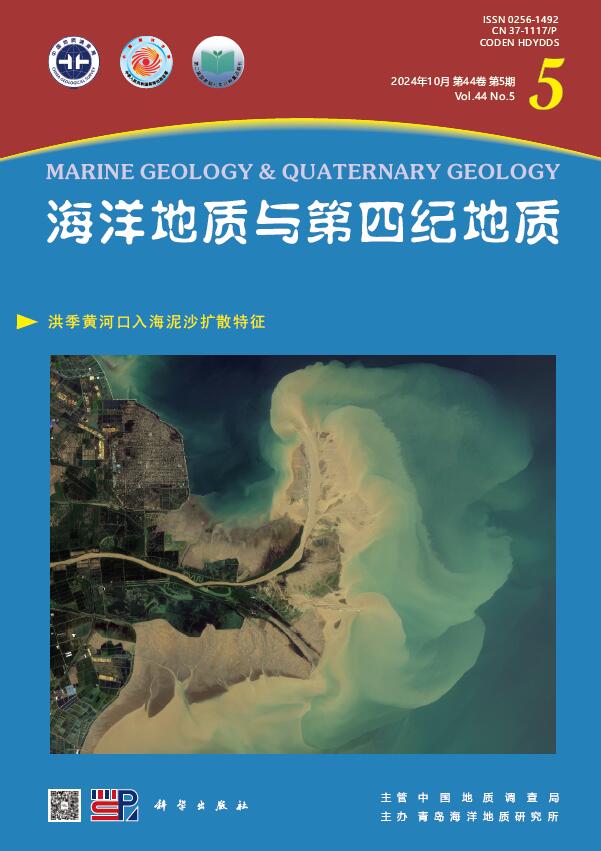东海内陆架泥区全新世有孔虫及其古环境意义:东海内陆架泥区全新世有孔虫及其古环境意义
引用次数: 10
摘要
东海内陆架泥区是全新世高海平面以来的沉积中心之一。该区保存的冰期后以来的沉积记录为研究全新世的古海洋和古环境变化提供了极好的资料。在泥区中部(121.89°E,28.17°N,水深32 m,岩心长35.3 m)恢复了MZ02岩心,并进行了放射性碳定年、粒度和有孔虫学分析,进行了古海洋和古环境重建。结果表明,全新世的环境演化可划分为4个阶段:10.8~10.5 cal.kaBP为海岸内陆架阶段,10.5~8.3 cal.kaBP为海岸内陆架向中陆架快速上升阶段,8.3~5.2 cal.kaBP为台湾暖流靠近研究区的内中陆架阶段,以及沿海流增强作用下的内陆架阶段。在8.4 cal.kaBP时,暖水物种丰度显著增加,表明台湾暖流入侵。底栖有孔虫δ18O较低、底栖有孔虫丰富度较高,与~4.0 cal.kaBP以来海岸流增强密切相关。本文章由计算机程序翻译,如有差异,请以英文原文为准。
HOLOCENE FORAMINIFERA FROM THE MUD AREA OF THE INNER SHELF,EAST CHINA SEA AND THEIR PALEOENVIRONMENTAL SIGNIFICANCE: HOLOCENE FORAMINIFERA FROM THE MUD AREA OF THE INNER SHELF,EAST CHINA SEA AND THEIR PALEOENVIRONMENTAL SIGNIFICANCE
The mud area on the inner shelf of the East China Sea is one of the depocenters since the high sea-level of the Holocene.Sedimentary records since the post-glacial saved in this area provide excellent materials for studying paleoceanographic and paleoenvironmental changes during the Holocene.The Core of MZ02 was recovered from the middle of the mud area(121.89°E,28.17°N,water depth 32 m,core length 35.3 m),and radiocarbon dating,grain-size and foraminiferal analyses were performed for paleoceanographic and paleoenvironmental reconstruction.Results show that the environmental evolution in the Holocene can be divided into 4 stages: the stage I was the coastal inner shelf during 10.8~10.5 cal.kaBP;the stage II was the period of the rapid sea-level rise from coastal shelf to the middle shelf during 10.5~8.3 cal.kaBP;the stage III was the inner-middle shelf with the Taiwan Warm Current close to the studied area during 8.3~5.2 cal.kaBP;and the stage IV was the inner shelf under the action of the enhanced coastal current.The abundance of warm-water species increased markedly at 8.4 cal.kaBP,suggesting the invasion of the Taiwan Warm Current since then.The lower δ18O in benthic foraminifera and higher abundance of epifaunal species are thought to be closely related to the enhancement of the coastal current since ~4.0 cal.kaBP.
求助全文
通过发布文献求助,成功后即可免费获取论文全文。
去求助
来源期刊
CiteScore
0.10
自引率
0.00%
发文量
4176
期刊介绍:
Marine Geology and Quaternary Geology launched in 1981 is a bimonthly academic journal sponsored by Qingdao Institute of Marine Geology, China Geological Survey, and published by the Science Press, China.The journal aims to publish original, cutting-edge, and explorative scientific results in the field of marine geology and sea-land Quaternary geology. The journal focus on reporting the latest research achievements supported by National Natural Science Foundation Project, National Key Project and International Cooperation Project, with priority to the results in China seas, global ocean and three poles, and the comparative study results between offshore and land, regional and global scientific issues.

 求助内容:
求助内容: 应助结果提醒方式:
应助结果提醒方式:


